Santa Caterina

Mystic of Holyhead (successor to Lynn Rival)
Rachel and Paul Chandler
Fri 3 Apr 2015 00:20
|
27:30.59S 048:31.40W With Lynn Rival secure on a yacht club mooring we hired a car for a few days to see more of the Island and a bit of mainland Santa Caterina. 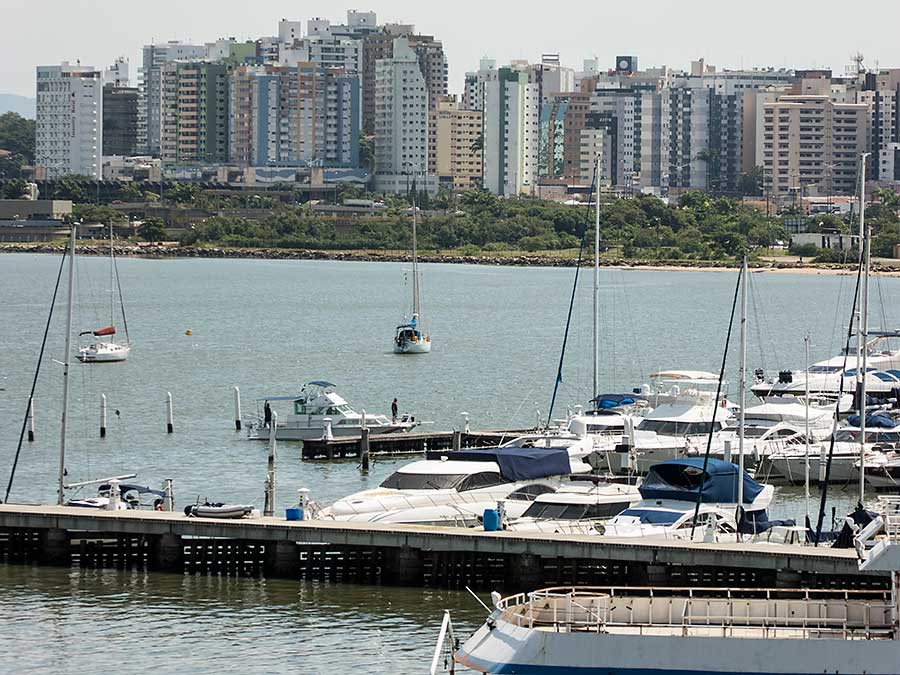 Lynn Rival on one of the few visitors' moorings, served by an efficient support RIB, run 24/7 by the Iate Clube staff Ilha de Santa Caterina is a popular tourist destination with green hills as a backdrop to long sandy beaches, good surf and clear waters for snorkelling. Because the bays between the island and mainland are shallow, there is no commercial shipping. It's a haven for wildlife, small scale fishing, sailing and surfing. And Floripa has good restaurants and shopping malls to suit all tastes.The north of the island - where we anchored in 2013 - is heavily developed and very busy during January and February. The tourist housing estates overshadow the lovely beaches. The south of the island is much nicer, with sheltered beaches on the mainland side where oyster, clams and mussels are farmed. The seafood restaurants are excellent, serving the local fish and shellfish in numerous ways. Some of the best beaches on the ocean side are only accessible by hiking, keeping them remote and peaceful, except for the roar of the surf. 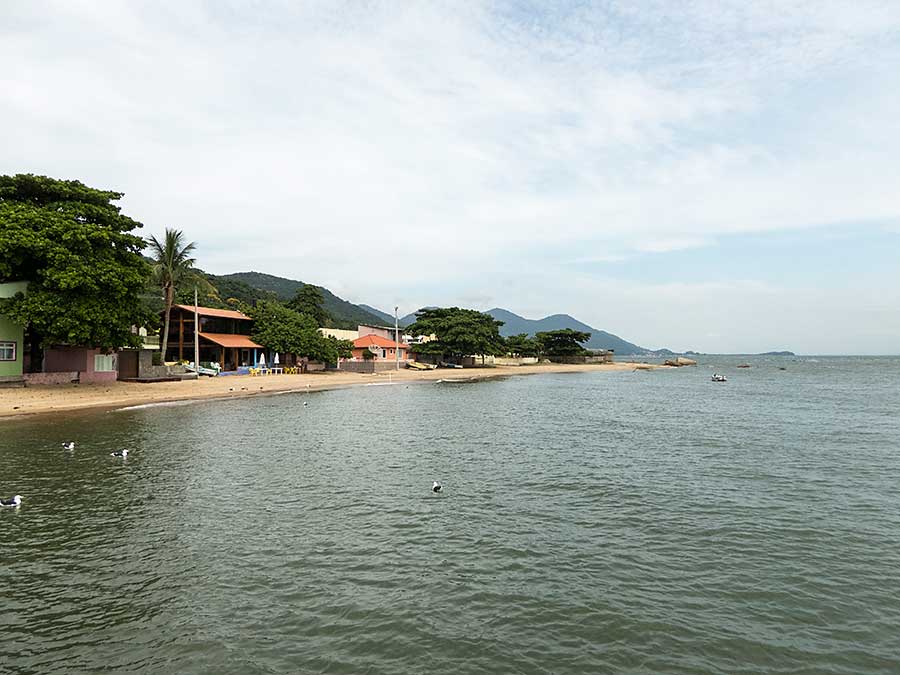 Evidently not high season, looking towards the southern tip of the island 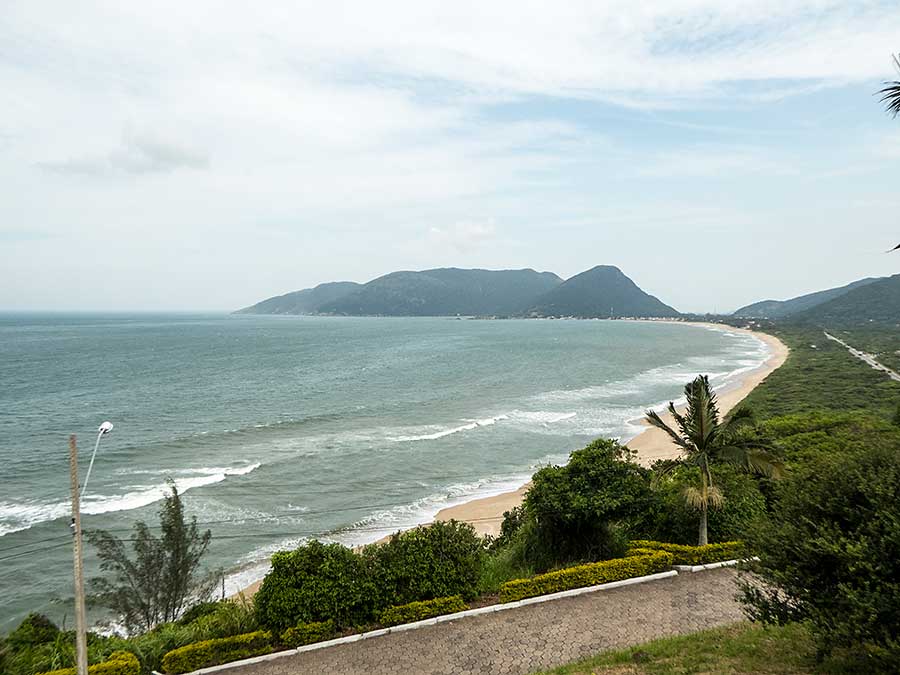 One of the more accessible beaches on the Atlantic side, often a magnet for surfers, but not today After a day of exploring the island we drove across the bridge to the mainland (called 'continente' by the locals) and headed southwest in search of the grassy highlands of the Serra Catarinense. This area is unique in Brazil: although the state of Santa Caterina is sub-tropical, here you get freezing weather and snowfall in winter. The scenery is very lush, scattered with araucaria forests - a pine related to the monkey puzzle tree. In the foothills, beef cattle - zebu - are common, as are men on horseback. The area is known for its gaucho culture and has much in common with neighbouring Rio Grande do Sul, Argentina and Uruguay - except that it's much more hilly than the latter.  A swathe of araucaria trees, in the foothills It was a cloudy, drizzly day. After about three hours - and a stop for lunch in a town called Orleans - we continued up a steep climbing road, the hillsides covered with woodland, including pretty purple-flowering Brunfelsia shrubs. We finally reached a viewing point at a place called Bom Jardim, but our luck was out. Instead of a spectacular view we saw just clouds. The numerous roadside stalls selling local produce: cheese, salami, apples, etc. were not doing much business that day. After winding our way down into valleys further west - and stopping to visit a waterfall - we came to the sprawling town of Urubici, where we planned to stay the night.  There are many viewpoints on the switchback road to Bom Jardim - at last we reached this one above the cloud! Urubici is a local hub. The nearby valleys are dotted with smallholdings and have a Tyrolean feel to them, with cows grazing and neat fields of cereals, cabbages and other crops. We had no difficulty in finding somewhere to stay and also a very good restaurant for supper. The tourist information office was very helpful and clearly this is a popular area for visitors - though from the surprised looks we got when responding to questions - few British make it here. Determined not to miss an opportunity, the next day we drove up the nearby Morro da Igreja which, at 1822m, is the highest peak in Santa Catarina. It is also where the lowest recorded temperature in Brazil ocurred in 1996: minus 17.8 degrees celsius. Halfway up we came to a checkpoint (there's a military base on the top) and had to persuade the guard that we really did want to go up even though the hill was shrouded in mist. Reaching the top we found that we were not the only mad people to have made the trip to see nothing but cloud. One other car was there with a Brazilian couple who joked with us about the tropical weather.  Another grand view! The inset shows what might have been seen - called 'punctured hole' in the tourist guide! Driving back to Floripa through valleys lined with brightly painted washboard houses, tidy fields of grazing cows and crops, apple orchards and occasional vineyards we were struck by how much more prosperous this area is compared to what we saw of its neighbours. The towns have more of a northern-European orderliness about them. No doubt due to the influence of the German, Polish and Ukranian settlers who came in the 19th century. And you see very few old bangers on the road. Despite the weather - drizzle much of the time - we returned to the boat on Saturday afternoon very impressed by the beautiful scenery and good infrastructure. The drizzle and cloud continued for another day so we stayed aboard and caught up with some Portuguese lessons. Since returning to Brazil we have been trying to forget Spanish but it keeps creeping back in everyday interactions. Of course some of the words - like the numbers - are very similar, but we're having difficulty remembering to say, for instance, "Obrigado/a" and not "Gracias".  The sun turned up again so we headed for the bridges . . .  . . . leaving a busy assembly line of S40s - gathering for their world championships to be held after Easter 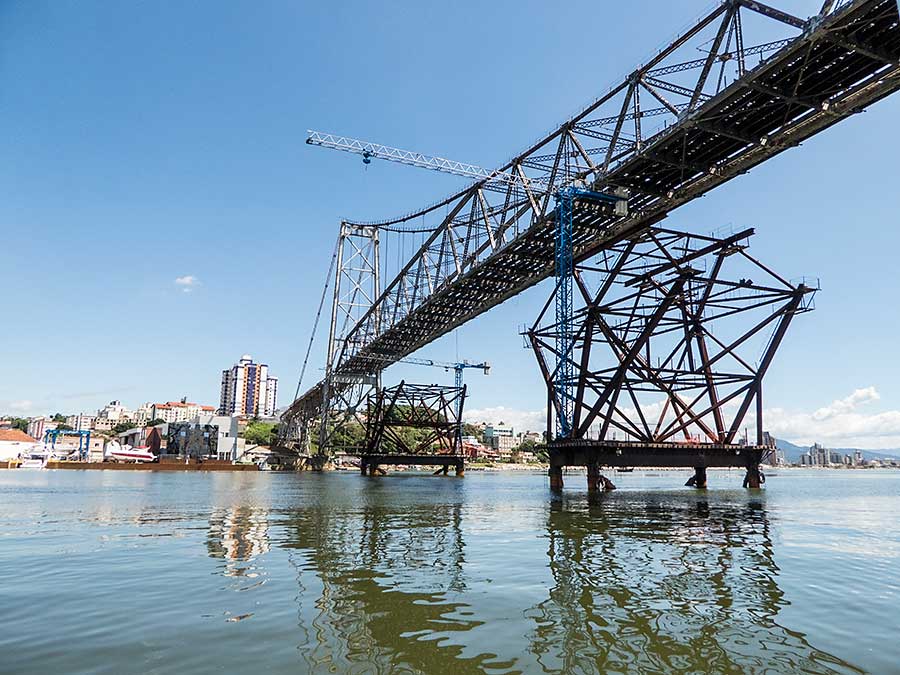 Either they are converting a suspension bridge to an arch bridge, or the new structures are to enable safe demolition!  We made it - at high tide too! On Monday we met up with Marco again. He'd been on a business trip to Mexico the previous week so was very busy but made time to help us sort out our 3G internet connection. We were having problems with our provider and Marco warned us that getting a reliable internet provider in Brazil is tricky. We now have 3 different SIMs, one of which is working. That night we treated Marco, his wife, Daniela, and their 3 young children to a pizza supper. It was the least we could do for all their help, including doing our laundry. 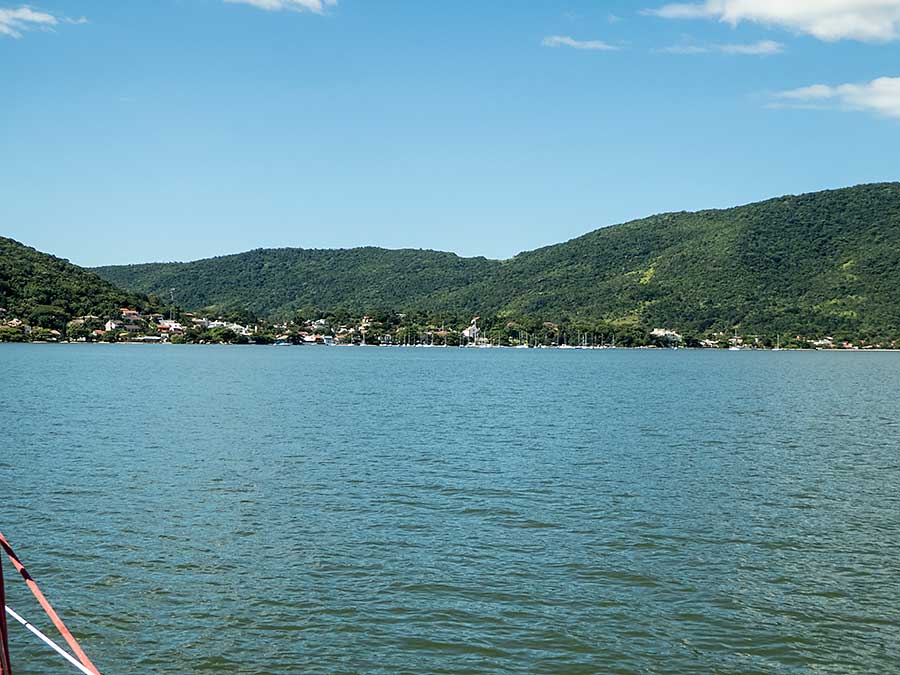 A much more peaceful anchorage, off the ancient (18th century) village of Santo Antonio de Lisboa With the weather clearing and a forecast for light winds, we left our yacht club mooring on Tuesday and motored under the bridge linking Floripa with the mainland. With only 17 metres clearance under the bridge it's a limiting factor for some when cruising here but fortunately Lynn Rival fits under with about 1 metre to spare. We then headed just a short distance - about 5 miles - up the coast to the pretty bay at Santo Antonio de Lisboa, carefully avoiding the shallows and rocks on the way. Approaching Santo Antonio our echo sounder stopped working. It would have been quite worrying had we not been here in 2013. There are quite a few yachts moored here and there is only limited room for anchoring before the bay gets too shallow. Fortunately we had the coordinates for where we had anchored in 2013 and so were able to head for the same spot. We are now happily at anchor, close to where Marco's sailboat is moored. Local fishermen come and go but otherwise it's very quiet. The fish are jumping and the seabirds fishing. The forecast is for fine weather and light winds for a few days so we're in "cruising mode" with no fixed schedule for when we'll move on. We can get in the dinghy and go ashore when we need fresh provisions or to visit one of the restaurants in the village. Or we can just stay aboard, have a swim, enjoy the freedom of being afloat. A few chores need to be done - like fixing the echo sounder - but we're not complaining. Happy Easter everyone! |